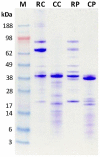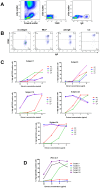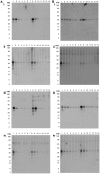IgE Reactivity of Blue Swimmer Crab (Portunus pelagicus) Tropomyosin, Por p 1, and Other Allergens; Cross-Reactivity with Black Tiger Prawn and Effects of Heating
- PMID: 23840718
- PMCID: PMC3686732
- DOI: 10.1371/journal.pone.0067487
IgE Reactivity of Blue Swimmer Crab (Portunus pelagicus) Tropomyosin, Por p 1, and Other Allergens; Cross-Reactivity with Black Tiger Prawn and Effects of Heating
Abstract
Shellfish allergy is a major cause of food-induced anaphylaxis, but the allergens are not well characterized. This study examined the effects of heating on blue swimmer crab (Portunus pelagicus) allergens in comparison with those of black tiger prawn (Penaeus monodon) by testing reactivity with shellfish-allergic subjects' serum IgE. Cooked extracts of both species showed markedly increased IgE reactivity by ELISA and immunoblotting, and clinical relevance of IgE reactivity was confirmed by basophil activation tests. Inhibition IgE ELISA and immunoblotting demonstrated cross-reactivity between the crab and prawn extracts, predominantly due to tropomyosin, but crab-specific IgE-reactivity was also observed. The major blue swimmer crab allergen tropomyosin, Por p 1, was cloned and sequenced, showing strong homology with tropomyosin of other crustacean species but also sequence variation within known and predicted linear IgE epitopes. These findings will advance more reliable diagnosis and management of potentially severe food allergy due to crustaceans.
Conflict of interest statement
Figures








Similar articles
-
Effect of thermal processing on T cell reactivity of shellfish allergens - Discordance with IgE reactivity.PLoS One. 2017 Mar 8;12(3):e0173549. doi: 10.1371/journal.pone.0173549. eCollection 2017. PLoS One. 2017. PMID: 28273149 Free PMC article.
-
Identification of tropomyosin and arginine kinase as major allergens of Portunus pelagicus (blue swimming crab).Trop Biomed. 2012 Sep;29(3):467-78. Trop Biomed. 2012. PMID: 23018510
-
Effect of heat processing on antibody reactivity to allergen variants and fragments of black tiger prawn: A comprehensive allergenomic approach.Mol Nutr Food Res. 2014 May;58(5):1144-55. doi: 10.1002/mnfr.201300584. Epub 2014 Jan 13. Mol Nutr Food Res. 2014. PMID: 24420734
-
Seafood-Associated Shellfish Allergy: A Comprehensive Review.Immunol Invest. 2016 Aug;45(6):504-30. doi: 10.1080/08820139.2016.1180301. Epub 2016 Jul 12. Immunol Invest. 2016. PMID: 27404324 Review.
-
Shellfish allergens: tropomyosin and beyond.Allergy. 2017 Jun;72(6):842-848. doi: 10.1111/all.13115. Epub 2017 Jan 19. Allergy. 2017. PMID: 28027402 Review.
Cited by
-
Allergens from Edible Insects: Cross-reactivity and Effects of Processing.Curr Allergy Asthma Rep. 2021 May 30;21(5):35. doi: 10.1007/s11882-021-01012-z. Curr Allergy Asthma Rep. 2021. PMID: 34056688 Free PMC article. Review.
-
Effect of thermal processing on T cell reactivity of shellfish allergens - Discordance with IgE reactivity.PLoS One. 2017 Mar 8;12(3):e0173549. doi: 10.1371/journal.pone.0173549. eCollection 2017. PLoS One. 2017. PMID: 28273149 Free PMC article.
-
Allergens and molecular diagnostics of shellfish allergy: Part 22 of the Series Molecular Allergology.Allergo J Int. 2016;25(7):210-218. doi: 10.1007/s40629-016-0124-2. Epub 2016 Nov 2. Allergo J Int. 2016. PMID: 28239537 Free PMC article. Review.
-
Tropomyosin and Actin Identified as Major Allergens of the Carpet Clam (Paphia textile) and the Effect of Cooking on Their Allergenicity.Biomed Res Int. 2015;2015:254152. doi: 10.1155/2015/254152. Epub 2015 Aug 27. Biomed Res Int. 2015. PMID: 26413512 Free PMC article.
-
Occupational Allergic Sensitization Among Workers Processing King Crab (Paralithodes camtschaticus) and Edible Crab (Cancer pagurus) in Norway and Identification of Novel Putative Allergenic Proteins.Front Allergy. 2021 Aug 23;2:718824. doi: 10.3389/falgy.2021.718824. eCollection 2021. Front Allergy. 2021. PMID: 35387003 Free PMC article.
References
-
- Ross MP, Ferguson M, Street D, Klontz K, Schroeder T, et al. (2008) Analysis of food-allergic and anaphylactic events in the National Electronic Injury Surveillance System. J Allergy Clin Immunol 121: 166–171. - PubMed
-
- Lopata AL, O'Hehir RE, Lehrer SB (2010) Shellfish allergy. Clin Exp Allergy 40: 850–858. - PubMed
-
- Lieberman P, Nicklas RA, Oppenheimer J, Kemp SF, Lang DM, et al.. (2010) The diagnosis and management of anaphylaxis practice parameter: 2010 Update. J Allergy Clin Immunol 126: :477–480+e471–e442. - PubMed
-
- Skypala I (2011) Adverse Food Reactions-An Emerging Issue for Adults. J Am Diet Assoc 111: 1877–1891. - PubMed
Publication types
MeSH terms
Substances
LinkOut - more resources
Full Text Sources
Other Literature Sources

